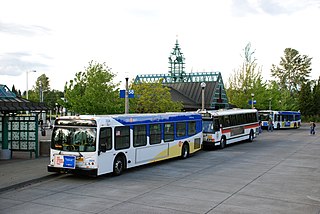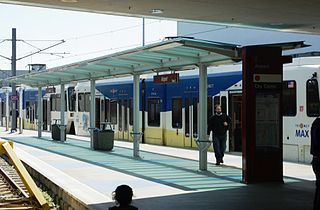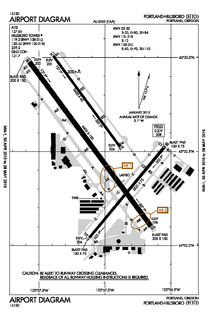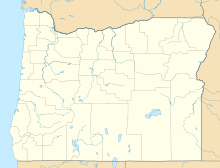
Beaverton is a city in Washington County, in the U.S. state of Oregon that is located 7 miles (11 km) west of Portland in the Tualatin Valley. The city is among the main cities that make up the Portland metropolitan area. Its population was 97,494 at the 2020 census, making it the second-largest city in the county and the seventh-largest city in Oregon. Beaverton is an economic center for Washington County along with neighboring Hillsboro. It is home to the world headquarters of Nike, Inc., although it sits outside of city limits on unincorporated county land.

Cedar Hills is a census-designated place and neighborhood in Washington County, Oregon, United States south of U.S. Route 26 and west of Oregon Route 217 and within the Portland metropolitan area. Constructed starting in 1946, Cedar Hills was the largest single housing tract development in the western United States at the time of its completion in 1961.

Republic Airport is a regional airport in East Farmingdale, New York, located one mile east of Farmingdale village limits.

The MAX Red Line is a light rail service in Portland, Oregon, United States, operated by TriMet as part of the MAX Light Rail system. An airport rail link, it serves 26 stations from central Beaverton through Portland City Center and Northeast Portland to Portland International Airport. From Beaverton Transit Center to Gateway/Northeast 99th Avenue Transit Center, the Red Line shares its route with the Blue Line and partially with the Green Line; it then branches to a 5.5-mile (8.9 km) segment to Portland International Airport station. Service runs for 22 hours per day with a headway of 15 minutes during most of the day. It is the second-busiest service in the MAX system; it carried an average of 10,310 passengers per weekday in September 2021.

Beaverton Transit Center is a transport hub located in Beaverton, Oregon, United States. Owned and operated by TriMet, it is a bus, commuter rail, and light rail station. The transit center is MAX Light Rail's 15th station eastbound on the Blue Line and western terminus on the Red Line. It is also the northern terminus of WES Commuter Rail and a hub for bus routes mostly serving the westside communities of the Portland metropolitan area. Beaverton Transit Center is situated on Southwest Lombard Avenue, just north of Southwest Canyon Road in central Beaverton, connected by walkway to Canyon Place Shopping Center. It recorded 9,709 average weekday boardings for all modes in fall 2018, making it TriMet's busiest transit center.

Portland International Airport, or just Airport on station signage, is a light rail station in Portland, Oregon, United States, operated by TriMet as part of the MAX Light Rail system. It serves Portland International Airport as the eastern terminus of the Red Line, which connects travelers to downtown Portland and Beaverton. The station is located near the southern end of the arrivals hall of the airport's main passenger terminal. It consists of a wedge-shaped island platform, just beyond which both tracks join because the section approaching the terminal is single-tracked. The station was built as part of the Airport MAX project; construction began in July 2000, and it opened on September 10, 2001. Trains serve the station for 22 hours daily with minimum headways of 15 minutes during most of the day. In late 2018, the station recorded an average of 2,461 weekday boardings.

Hillsboro Airport, also known as Portland–Hillsboro Airport, is a corporate, general aviation and flight-training airport serving the city of Hillsboro, in Washington County, Oregon, United States. It is one of three airports in the Portland, Oregon, metropolitan area owned and operated by the Port of Portland. Established in 1928, it is Oregon's second busiest airport at over 200,000 operations annually.

Washington Square is a shopping mall in the city of Tigard, Oregon, United States. Located in the Portland metropolitan area along Oregon Route 217, the shopping complex is one of the top grossing malls per square foot in the United States, with sales of $716/ft². Opened in 1973, the mall is currently managed and co-owned by The Macerich Company, a real estate investment trust, and is anchored by Macy's, Nordstrom, JCPenney, and Dick's Sporting Goods.

Grove Field is a public airport located three miles (5 km) north of the central business district of Camas, a city in Clark County, Washington, United States. It is located near Lacamas Lake which has a seaplane base. Due to the closing of Evergreen Field, many aircraft have moved to Grove Field.

The Swan Island Municipal Airport was a joint civil-military airport that was operational on Swan Island in Portland, Oregon. Though it officially opened in 1927, the United States Postal Service had been using the airfield for a year. After the Portland–Columbia Super Airport was completed in the late 1930s, Swan Island Municipal Airport had little use since its runways were too small for newer aircraft and the low altitude made takeoffs and landings difficult. The airport was operational for nearly two decades, but due in part to the advances in aviation, it became obsolete soon after its construction. During World War II, a Kaiser shipyard was located at Swan Island. The shipbuilding facilities were acquired by the Port of Portland after the war.

Burns Municipal Airport is six miles east of Burns, in Harney County, Oregon. The National Plan of Integrated Airport Systems for 2011–2015 categorized it as a general aviation facility.

Cedar Hills Crossing, formerly Beaverton Mall, is a retail shopping center in the city of Beaverton, Oregon, United States. The center is notable in that it was the prior site of a historic airport, Bernard's Airport, where many of the early aircraft innovations of the 1920s and 1930s occurred. Cedar Hills Crossing has been in operation since 1969, and is located approximately between the intersection of SW Cedar Hills Boulevard and Walker Road and the intersection of SW Cedar Hills Boulevard and Hall Boulevard. The current name was adopted in September 2002 when C.E. John Company began the redevelopment of the Mall. Three extra mall entrances, new building facades and 40,000 square feet (3,700 m2) of new retail space was involved in the redevelopment, including new restaurants and interior designs.
Charles E. Bernard was an American aviation pioneer who developed Bernard's Airport, in Beaverton, Oregon, United States.

Apple Valley Airport is a private airport located one mile southeast of Buxton in Washington County, Oregon, United States. Built in 1994 by a Portland TV personality Rod Anders, the subsequent owners have pushed to expand operations at the airport. Near U.S. 26 west of the Portland metropolitan area, the 2,470 feet (750 m) long turf airstrip is used for agricultural operations.

Olinger Strip Airport is a private airport located 3 miles west of Hillsboro in Washington County, Oregon, United States. Located in the unincorporated community of Leisyville, the air strip is a single, 2,000-foot (610 m) long runway with houses running the length of the field on the north of the strip.

Sunset Air Strip is a private airport located one mile southwest of North Plains in Washington County, Oregon, USA. There are 16 aircraft based at the strip, which is managed by Roth Development Corp., which is owned by the neighbors. Some of the 17 neighbors to the strip have hangars on their property. The strip is owned by Roth Development, and the number of aircraft is limited to 50 by the Oregon Department of Aviation.

Vance Breese (1904–1973) was an American aviation engineer and test pilot.
The Classic Aircraft Aviation Museum is an aviation museum located in Hillsboro in the U.S. state of Oregon. Started in 1998, the museum is located at the Hillsboro Airport in the Portland metropolitan area. Aircraft at the museum are either maintained in flyable condition or are restored so that they can be flown once again. As of March 2010, there were 15 aircraft in the museum's collection and Doug Donkel served as museum director.
Rodgers was a chain of five-and-dime stores based in Portland, Oregon, which was in business for 60 years, from 1938 to 1998. The chain's largest store was believed to be the largest independent variety store on the U.S. West Coast at the time of its opening in 1955. It occupied a newly constructed three-story, 100-by-100-foot building in Portland's Hollywood District and replaced two successive previous stores in that area.

Gurugram Airstrip, also Bhondsi Airstrip and Silokhera Airstrip, is an airstrip located between Silokhera and Bhondsi villages, 10 kilometres (6.2 mi) south of Gurugram city center, in Haryana state of India.




















